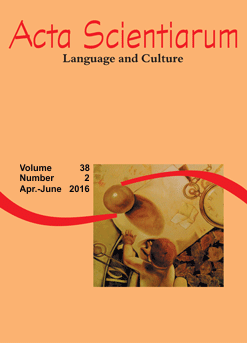<b> gênero questão interpretativa como ferramenta de ensino de leitura
Résumé
A aprendizagem da interpretação é negligenciada na esfera educacional, contrariando proposições teóricas da concepção interativa da linguagem. Os gêneros discursivos típicos do ambiente escolar – como as questões – não são, de modo geral, ensinados formalmente. Nossa proposta neste artigo é apresentar o gênero discursivo Questão Interpretativa enquanto ferramenta de aprendizagem da interpretação, levando em conta sua produção colaborativa entre interlocutores para a realização do texto-questão e do texto-resposta. Para tanto, apoiamo-nos nos pressupostos teóricos da Linguística Aplicada, respeitando a orientação teórica proposta pelo Círculo de Bakhtin de concepção de linguagem enquanto interação, bem como sua concepção sobre os gêneros do discurso e as orientações teórico-metodológicas da Análise Dialógica do Discurso, suportados ainda pelos pesquisadores respondedores a questões dessa natureza, como Menegassi, Sobral, Fiorin, Travaglia, Rojo etc. Nosso corpus constitui-se de um texto-questão e textos-respostas produzidos por professores em formação inicial do primeiro ano de Letras da Universidade Estadual de Maringá. Os resultados da investigação indicam que a interpretação configura a interação entre o sujeito que a produz e seu(s) interlocutor(es), os textos retomados no gesto interpretativo. Assim, a interação social ocorre através da interpretação, ratificando a Questão Interpretativa como ferramenta de aprendizagem dessa etapa da leitura.
Téléchargements
DECLARAÇÃO DE ORIGINALIDADE E DIREITOS AUTORAIS
Declaro que o presente artigo é original, não tendo sido submetido à publicação em qualquer outro periódico nacional ou internacional, quer seja em parte ou em sua totalidade.
Os direitos autorais pertencem exclusivamente aos autores. Os direitos de licenciamento utilizados pelo periódico é a licença Creative Commons Attribution 4.0 (CC BY 4.0): são permitidos o acompartilhamento (cópia e distribuição do material em qualqer meio ou formato) e adaptação (remix, transformação e criação de material a partir do conteúdo assim licenciado para quaisquer fins, inclusive comerciais.
Recomenda-se a leitura desse link para maiores informações sobre o tema: fornecimento de créditos e referências de forma correta, entre outros detalhes cruciais para uso adequado do material licenciado.




















6.png)









